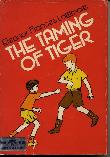- Judge Neil Gorsuch on education law issues [Clint Bolick and Marty West, Education Next] And if you haven’t read Gorsuch’s dissent in the “burping student” case, A.M. v. Holmes — among his most famous opinions — it’s here;
- Tables for sharing food at cafeterias: “‘It’s the same objections every single time,’ he said. ‘There’s this myth that they’re going to get sued.'” [Michael Melia, AP/Yahoo]
- “Why heroin and classroom sex aren’t enough to get teachers fired anymore” [Julia Marsh, New York Post]
- “…a story of the pitfalls that await teachers who make extended efforts to aid troubled students.” [Andrew Marra, Palm Beach Post]
- St. Paul, Minn. saga of school discipline and “disparate impact,” cont’d [Katherine Kersten, earlier here, here, and here]
- “I first found ‘Free Range Kids’ from the Overlawyered site” — one commenter’s tale of the fate of children’s books at a local library after CPSIA came in [Free-Range Kids]
Posts Tagged ‘CPSIA and books’
CPSIA de la Plata? Argentina un-bans book imports
Following a worldwide outcry, Argentina has promised to lift restrictions on the importation of foreign books, which had purportedly been based on fear of dangerous lead content in the ink. According to a report by my Cato colleague Juan Carlos Hidalgo:
“If you put your finger in your mouth after paging through a book, that can be dangerous,” said Juan Carlos Sacco, the vice-president of an industrialist organization that supports the measure.
MercoPress carries reporting in English translation on the original measure and on the promised reversal. Under the rule of President Cristina Fernandez, the Argentine government has taken a number of steps considered hostile to press critics, including controls on the newsprint business, and criminal charges against economists who report that prices are rising faster than the official inflation index.
Where did the Argentine officials get the idea that lead in book inks might be enough of a public health problem to justify drastic government action? Maybe from the U.S. Congress. As I explained in this City Journal piece, the notoriously extreme and poorly drafted 2008 CPSIA law imposed across-the-board requirements for lead testing of older children’s products, with the result that, according to guidance from the U.S. Consumer Product Safety Commission, it was considered doubtfully lawful to sell or distribute most pre-1985 books for children. That set of restrictions was eventually relaxed, following a massive outcry from dealers, publishers, libraries and lovers of children’s books.
“There Is No Joy In Toyland”
Former Congresswoman Anne Northup, now a commissioner at the Consumer Product Safety Commission, 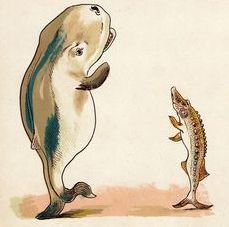 had an op-ed in the Journal last week on the continuing damage being wrought by the Consumer Product Safety Improvement Act (CPSIA). Related: Rick Woldenberg (“Big Toy may be prospering right now, but the little guy is getting killed”). And Karen Raugust at Publisher’s Weekly has a year-end status report on the unpleasant effects of the law on various segments of the kids’ book business, including retailers, “book-plus” and novelty book makers, and one of the most seriously endangered groups, sellers of vintage children’s books.
had an op-ed in the Journal last week on the continuing damage being wrought by the Consumer Product Safety Improvement Act (CPSIA). Related: Rick Woldenberg (“Big Toy may be prospering right now, but the little guy is getting killed”). And Karen Raugust at Publisher’s Weekly has a year-end status report on the unpleasant effects of the law on various segments of the kids’ book business, including retailers, “book-plus” and novelty book makers, and one of the most seriously endangered groups, sellers of vintage children’s books.
PUBLIC DOMAIN IMAGE from Elise Bake, Der Ball Der Tiere (“The Animals’ Ball”, German, 1891), courtesy ChildrensLibrary.org.
CPSIA: “The Waiting Game Continues for Libraries”
Karen Raugust, Publisher’s Weekly, on some recent clarification (not exactly relief) for makers and sellers of new books under the Draconian law:
The Consumer Products Safety Commission recently issued a final lead rule that deemed many—but not all—of the components in ordinary children’s books safe. …
Most ink-on-paper and ink-on-board books will not have to undergo testing under various CPSC rulings. (Some so-called “ordinary” books, such as those with gold foil or spiral bindings, must be tested, and big retailers may require testing even when the CPSIA doesn’t.) All novelty and book-plus formats for children 12 and under must be tested by independent labs.
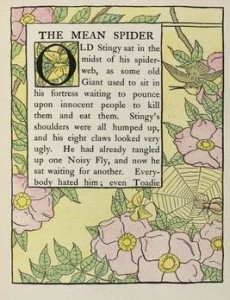 However, the CPSC has yet to issue promised guidance to libraries on pre-1985 books:
However, the CPSC has yet to issue promised guidance to libraries on pre-1985 books:
Thom Barthelmess, president of the Association for Library Service to Children, a division of the American Library Association, says most librarians are waiting to see what happens. “We’re hoping for a happy resolution, so our collections aren’t decimated,” he says. If the CPSC’s ruling results in libraries needing to pull books from shelves, “there would be huge ramifications,” he continues. “If we lose a lot of titles printed before 1986, many of which are irreplaceable, it would have a huge impact on the nature of our collections.”
We’ve linked the coverage in Publisher’s Weekly several times over the course of the year but overlooked this report from March:
Most booksellers are now comfortable selling ordinary paper children’s books printed in 1986 and beyond. …
Half Price [Half Price Books, a large chain] removed all book-plus items from the shelves in every store and is warehousing them while it researches how to dispose of them in a safe and environmentally sound way, perhaps at a hazardous waste site.
And an official of the Independent Online Booksellers Association told PW in March that most members of the association were positioning their vintage children’s books as adult collectibles, which supposedly reduces legal risk, though as we noted in February, “the law provides that [retailers] are liable if they sell a product which will commonly be understood as destined for use by children, whether or not they label it as such.” Deputy Headmistress in February and Valerie Jacobsen in March also explained more about the practical drawbacks of the “relabel as collectibles” dodge, as has Elizabeth Mullaney Nicol more recently.
P.S. And welcome listeners at Hartford’s WTIC, where host Ray Dunaway had me as a guest on his show this morning to discuss the law. You’ll find much more here.
PUBLIC DOMAIN GRAPHIC: Edith Brown, illustrator, Jeannette Marks, The Cheerful Cricket and Others (1907), courtesy The Children’s Library.
CPSIA: WSJ reactions
My Monday piece in the Wall Street Journal on the many failings of the Consumer Product Safety Improvement Act drew links and reactions from Holly Jahangiri, Jonathan Adler at Volokh (including an interesting, if not particularly CPSIA-related, commenter anecdote about old books and library guidelines), Peter Reynolds/Return Play to Kids, Katherine Mangu-Ward/Reason “Hit and Run”, Carter Wood/ShopFloor, Bookworm Room, and Hans Bader/CEI “Open Market”. The WSJ comments also include one from Bill Upton of Ann Arbor, Michigan which includes the following disturbing assertion: “The CPSC has ruled that the paper, internal bindings and standard inks in [post-1985] children’s books are safe, but other standard components, including the top-coatings used to protect the vast majority of book covers, still don’t have a green light.”
CPSIA: miscellaneous reading
Commentaries from various quarters on the dreadful child-safety law:
- “Hope and change — and children’s books” [Michael Barone, D.C. Examiner; note however that the law at present does not allow for general enforcement by private lawyers] More on kids’ books: Morton Goldberg, “Inoculated”; Books Bikes Boomsticks (“I don’t think I’ve ever felt quite the quiver of rage I felt” on learning of book angle); Deputy Headmistress (reacting to that post); Grad Student Madness (waiting for the black market to spring up in vintage kids’ books). Esther at Reader’s Loft has drawn up some decision flow charts that may help in determining whether a particular kids’ book needs expensive testing under the law. And “If Your Kid Eats This Book, Everything Will Still Be Okay” — that’s the title of a new book offering child health advice, not a CPSIA critique [ER Stories]
- “Lead-footed safety issues” [Carter Wood, Washington Times] And let’s hope Washington Post editors take the time to read their own paper [same at ShopFloor]
- Lenore Skenazy, “The risk of avoiding all risk” [The Post Chronicle; see also Rick Woldenberg]. Related: “More toys from our youth that’d be illegal today” [Doug Ross] And you just know this one’s European, not U.S. [Berg Toys “Moov”]
- Suppose Congress had never passed CPSIA — what would be the actual risk that your child would suffer lead poisoning from his dirtbike or other playthings? Essentially zero, as Rick Woldenberg explains in a post from this spring somehow unlinked before now. Indeed, ordinary dirt, which kids have been known to get on their hands and faces from time to time, contains higher concentrations of naturally occurring lead than many of the products whose makers have been hard hit by the law. Likewise, Deputy Headmistress explodes a few myths of CPSIA proponents. And what’s this about infinitesimal residues in children’s vitamins being (no doubt correctly) deemed safe by the federal government?
- Finally, the valuable site What Is the CPSIA, which is organized as a sort of FAQ to answer common questions about the law, has added substantially to its content in recent weeks and well repays a repeat visit.
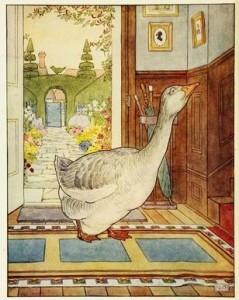
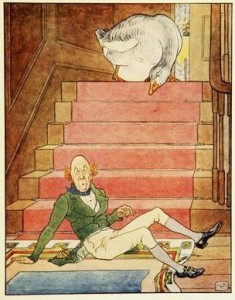
PUBLIC DOMAIN IMAGES from Leslie Brooke, illustrator, Oranges and Lemons: A Nursery Rhyme Picture Book (1913), courtesy ChildrensLibrary.org.
CPSIA developments; posting lull
I’ve got an out of town trip over the next few days, so posting from me is likely to consist of a relatively few scheduled short posts.
There have been several important developments with CPSIA over the past month, to which time has not yet permitted me to do justice. In particular, the CPSC late last month issued guidance on the tracking-label rules that take effect later this week. Its interpretation is more lenient on several issues than most observers were expecting, particularly for craft and small-batch producers, but the rules remain a gigantic headache for thousands of businesses.
Even more recently, the commission offered further guidance on a few other issues, notably its interpretation of what materials will be considered inherently free of lead under normal circumstances. These new rules are being cautiously welcomed as helpful to some in (for example) the apparel trade, but they are unfortunately bad news for friends of many other products, in particular vintage children’s books, which are not going to be considered intrinsically safe. Finally, the commission appears to be giving off some favorable signals on the issue of “component testing” (i.e., avoiding endless and costly re-testing of already-tested product components).
I hope to treat these new developments at more length in future posts. In the mean time, here are some relevant links:
Tracking labels: commission action and policy in PDF, Rick Woldenberg coverage, Kathleen Fasanella/Fashion Incubator, Buggalove, Play Meter (scroll to 7/27), Greco Woodcrafting, Publisher’s Weekly and earlier, Hugh Hewitt.
Intrinsically safe materials: CPSC final rule in PDF format, Rick Woldenberg and more, The Smart Mama.
The fate of vintage books: Deputy Headmistress and more, Rick Woldenberg, and — from back in the spring but not linked then — Assistant Village Idiot, Deputy Headmistress, Carter Wood, and Valerie Jacobsen as well as more.
Welcome Volokh Conspiracy readers
Following two posts by Jonathan Adler, readers there are discussing CPSIA’s effects on vintage kids’ books and on rhinestones and crystals. More: Glenn Reynolds, Instapundit (with link to Adler), Megan McArdle (linking to my City Journal piece). And Joseph Bottum at First Things has generous words for our coverage of the story.
CPSIA and books: “A bad law threatens our past”
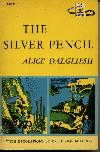 Elizabeth Mullaney Nicol has an excellent article in The New Atlantis on the Consumer Product Safety Improvement Act and its appalling consequences for old children’s books and the cultural inheritance they represent. (If you’re new to this topic, we’ve covered it extensively here and here.) Among the questions she addresses:
Elizabeth Mullaney Nicol has an excellent article in The New Atlantis on the Consumer Product Safety Improvement Act and its appalling consequences for old children’s books and the cultural inheritance they represent. (If you’re new to this topic, we’ve covered it extensively here and here.) Among the questions she addresses:
Isn’t there a wealth of worthwhile children’s literature published since 1985 for kids to read?
[Older books,] as a group, have certain desirable characteristics. Children’s books of yore tend to use more sophisticated, literary language than their more recent counterparts. The quality of their paper, bindings, and illustrations are often superior. Vintage children’s books assume and encourage the readers’ fascination with adventure, their eagerness to learn about the world, their respect for great men and women.
Won’t the really good older books survive in post-1985 reprint editions that can be sold without fear of liability? (Yes, one really does hear this argument.)
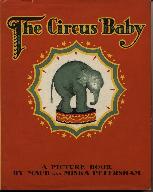
Some books from the 1950s and 60s are back in print, but with updated illustrations so the characters appear to be from our time; if that’s what it takes to lure readers who are wary of anyone who doesn’t look like them to pick up the books, it’s probably fine, but there is also value in presenting books with a style of illustration and characters with a style of dress from a different time, and that’s what we get with old copies. Some books, such as the Hardy Boys and Nancy Drew series, are thoroughly “updated” for today’s readers—simplified, abbreviated, substituting familiar words for those no longer commonly used—so if a child is going to read the originals he needs to read old copies….
Some old books, it is true, express ideas and attitudes of which we would disapprove, prejudices and errors that make modern readers wince. But learning about such sentiments firsthand is at the heart of what it means to learn our history. Moreover, while correcting some of these past problems, our present age has its own objectionable attitudes.
Won’t older children’s books still be available when intended for adult use, say as collectibles or for research?
But the availability of these books to children is the very purpose and value of preserving them. We want them in children’s hands, being read, not only preserved on the dusty back shelves of research libraries. Quantities are important — quantities of titles, and quantities of each title, so they are readily available for loan from public libraries and for purchase through used booksellers. Families have been able to build home libraries through priced-for-reading book sales and thrift stores. … We are suddenly facing the prospect that many of these books will be destroyed, making those that remain all the more rare and inaccessible.
Some used booksellers, trying valiantly to continue selling books for children, are re-labeling their children’s books as collectors’ editions. But this obscures the books from searches by those looking for ordinary children’s books, it clutters the market for real collectibles, it makes the bookseller look ignorant of his trade, and it is prohibited under CPSIA, which stipulates that a book “commonly recognized” as being meant for children’s use will be regulated as such.
The article’s strength, I should note by way of quibble, is not as legal advice: it somewhat overstates the stringency of the law, which does not ban the sale of all untested pre-1985 kids’ books as such, instead exposing booksellers to punishment when they guess wrong about whether a given volume would meet current standards (hence the CPSC’s guidance advising retailers to discard them all). And the call for “sequestering” library copies has thus far come from only one member of the three-member CPSC, not as yet the full commission. As a summation of what will be lost to children and the nation if Congress does not change this law, however, the article is one of the best yet. Read it here.
Relatedly, Ken at Popehat is still trying to grasp the news that according to our federal government:
Children’s books have limited useful life (approx 20 years)
And since Rep. Henry Waxman, closely identified with CPSIA and its defense, has a new book out, Carter Wood at ShopFloor wonders whether this topic is going to come up at any of his bookstore appearances.
P.S. Fenris Lorsrai at LiveJournal reprinted the Nicol article and in so doing prompted some interesting reader comments.
GRAPHICS courtesy VintageChildrensBooks.com.
CPSIA chronicles, June 18
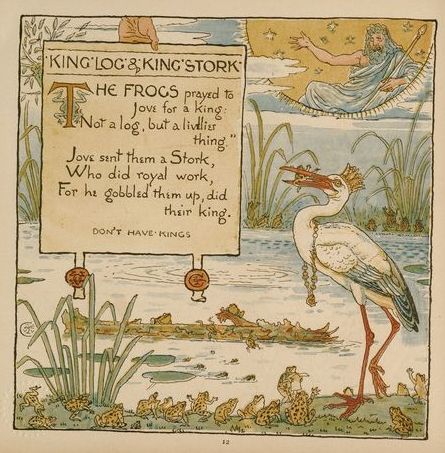
- As noted earlier, the next all-out debacle on the CPSIA front is expected to result from the law’s tracking and labeling regulations, due to take effect August 14, and for which the CPSC has not yet issued guidance, although product makers ordinarily need to resolve crucial issues of manufacturing (as with etching of lot numbers) and packaging at least many months if not longer in advance of sale. Sharon McLoone at CNNMoney had quite a good report a week ago on this latest crisis, which as of this writing has not been followed up much of anywhere else in the press. This continues the pattern in which 1) most key elements of the ongoing CPSIA disaster get good coverage in at least one (sometimes more) major media outlets; 2) the bigger-picture disaster of the law never quite succeeds in breaking out into general coverage as a national story, in large part because 3) the agenda-setting New York Times never consents (even six months into the story!) to give the matter any coverage at all. For more hints on the approaching tracking-label train wreck, see this op-ed by a South Carolina maker of school supplies (“Companies such as ours are now forced to guess about their new legal requirements. … My company may have to change labels hundreds of times a week in our two factories. The investment necessary to handle this new rule alone is crippling.”), or the comments of appliquéd bib maker Laurel Schreiber of Lucy’s Pocket (if the testing doesn’t get her, the tracking labels will), or of New Jersey wooden toy maker John Greco (advised that tracking info would add $3.50 to $5.00 to cost of making $10 handmade toy). And here’s a view from the home furnishings business.
- No, the menace to pre-1985 children’s books has not gone away, not in the least. Librarians and publishers remain on the edge of their seats awaiting exemptions, clarifications or both. There was some good coverage last month in the Sioux Falls Business Journal (store owner Jenny Cook “had to throw out only 30 books at her store to comply” because most were newer; “Siouxland Libraries has pulled a list of books that were published before 1985”) and at Syracuse.com (“When you think through the implications, it means closing our libraries to children”). And in a sign of possible things to come, ABC-affiliated stations in Seattle and Washington, D.C. have now run sensationalist “toxic books!” attacks on local libraries [Common Room, ShopFloor] More: Winifred Maker, Anderson Valley Post (April).
- The CPSC’s stay of enforcement didn’t really solve the problem of the ban on dirtbikes and mini-ATVs, and responsible users and dealers end up getting the short end of the stick [Jason Giacchino/ATVSource, Vince Castellanos/ESPN FMX, Motorcycle Industry Council, Charleston (S.C.) Post and Courier]
- Downtown Los Angeles is home to an estimated 500 toy companies — most of them far smaller than crosstown giant Mattel — and they’re in much distress from the law. [Alexa Hyland, L.A. Business Journal] The L.A. Times, which once gave serious scrutiny to the law’s effects on the apparel and resale sectors, seems (scroll) to be dropping the ball.
- Those who remain in the kids’-product business after coping with all the other parts of the law will also want to educate themselves about “recall escrows” [Rick Woldenberg]
- Inez Tenenbaum, named by Obama as new CPSC chair, had her confirmation hearing on Tuesday [ShopFloor and more, Rick Woldenberg]. Nancy Nord earlier stepped down from her role as acting chair.
- What, what, what could they have been thinking? The American Library Association has actually given its 2009 Public Service Award to California Senator Barbara Boxer, a key architect of some of CPSIA’s provisions; the retroactive phthalates ban she championed has been especially effective in forcing “books-plus” off library shelves, and she has turned a coldly unsympathetic ear to cries of distress over the law (via @melanes). To repeat: what could the ALA have been thinking?
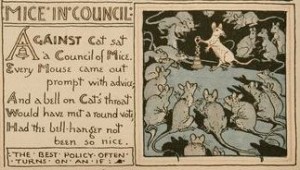
Public domain images courtesy ChildrensLibrary.org: Walter Crane, illustrator, The Baby’s Aesop (1887).

